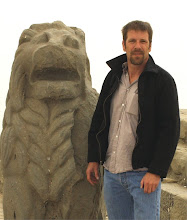 One of the drawbacks to eager exploration is forgetting to get the name of the location that you are trying to learn about. The benefit on the other hand is the requirement to return to the same spot to fill in the gaps!
One of the drawbacks to eager exploration is forgetting to get the name of the location that you are trying to learn about. The benefit on the other hand is the requirement to return to the same spot to fill in the gaps!Still wiped out from the lack of sleep from the late night flight and the crash course (figuratively speaking) in middle eastern driving techniques, there was still that gnawing desire to find something special, something to claim as my own first discovery in a distant land. Such is what for the moment is to be known as the nameless kilisesi somewhere slightly Northeast of Göreme.


After a short walk through the orchards and meadows it was time to try to negotiate a path that really didn't exist. Sure, there were bare spots among the weeds and trees, but no definitive trail, no signs directing the visitor to that elusive entrance. And then there it sits, a stone stairway leading down to a heavy metal door, then, crap, the discovery that this is only the maintenance shed/cave. The real entrance is further up the hill over a few piles of rocks and some makeshift steps carved out of the dusty earth. After paying the nice man at the entry 3 Lira, you are handed an old tin flashlight and he gestures some very simple instructions that really required no translation. The flashlight must be jiggled intermittently to ensure that the batteries maintain the correct position or you could be left in the dark. These are instructions that must be followed, because once inside the cave, you are on your own!

Passing through the gate though, the magic seems to take over. Even though it seems to be plainly ornamented with some red pigment, simple lines and symbols you can't help but wonder who had done this and how and why. With the limited amount of light, how were they even able to define the lines? What tools were used to carve out these rooms and passage ways? Considering that the original caves had been carved out roughly two thousand years earlier as living and community areas as well as shelter from the elements and enemies these areas were created out of necessity. Add to this the fact that, in some cases, nearly 1,200 to 1,400 years ago these dwellings were commandeered by religious orders or zealots, and not always without bloodshed, and converted to their own use, altered and decorated in a manner appropriate to their beliefs, these structures take on a significant role in human history. A large part of the fun in exploring these caves is that there is a maze of passageways to navigate and many times there is no light at the end of the tunnel, just a big, dark room!
 The massive stone doors are nothing less than intimidating, especially after having negotiated several twists and turns hunched over in a tunnel and fighting a tempermental flashlight. That annoying thought springs to mind, "What if there were a massive earthquake and that door somehow managed to dislodge and roll closed. And where does that dark stairway lead to?" Little thoughts like that, though drift away as you turn the next corner.
The massive stone doors are nothing less than intimidating, especially after having negotiated several twists and turns hunched over in a tunnel and fighting a tempermental flashlight. That annoying thought springs to mind, "What if there were a massive earthquake and that door somehow managed to dislodge and roll closed. And where does that dark stairway lead to?" Little thoughts like that, though drift away as you turn the next corner.
Apart from ventilation shafts and what seem to be waste repositories (nice way of saying sewerage pits) there are other mysterious pits and holes to watch out for in the floors. There is almost a hint of Indiana Jones type adventure, only without the treasure and the beautiful yet bitchy side kick.
Working your way up through the stairwells, if they can really be called that, and skull craking hobbit sized doorways you do come into some very remarkable rooms! More on that later.

No comments:
Post a Comment